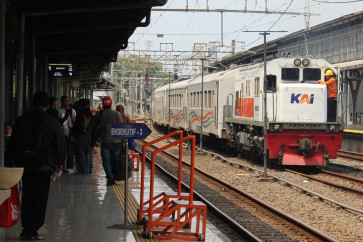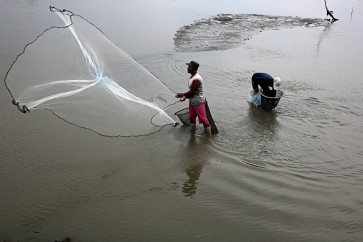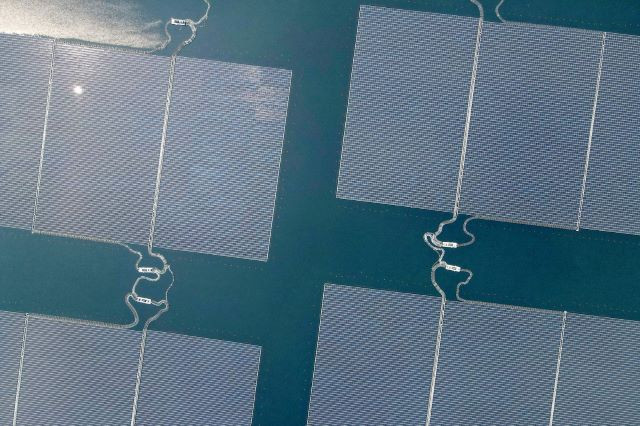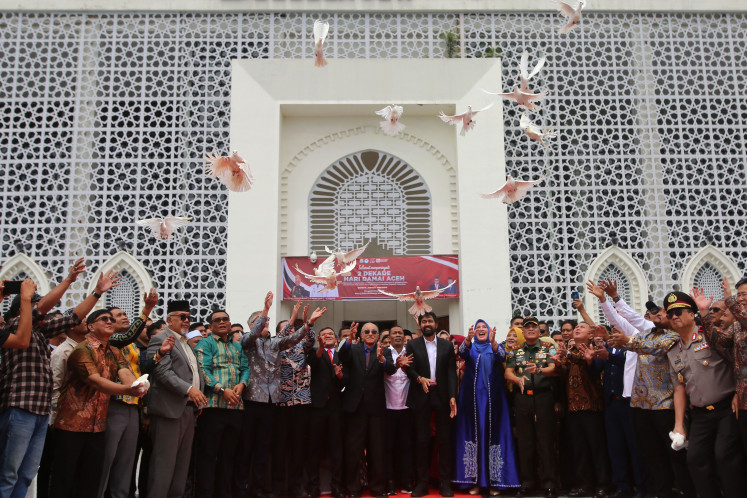Popular Reads
Top Results
Can't find what you're looking for?
View all search resultsPopular Reads
Top Results
Can't find what you're looking for?
View all search resultsKorea's Jeju Island, a seaside story
I am a haenyeo: Three haenyeo (Jeju female divers), which are on average aged 60 and above, make their way home after collecting products in the sea
Change text size
Gift Premium Articles
to Anyone
 I am a haenyeo: Three haenyeo (Jeju female divers), which are on average aged 60 and above, make their way home after collecting products in the sea. (thejakartapost.com/Elly Burhaini Faizal)" border="0" height="365" width="512">I am a haenyeo: Three haenyeo (Jeju female divers), which are on average aged 60 and above, make their way home after collecting products in the sea. (thejakartapost.com/Elly Burhaini Faizal)
I am a haenyeo: Three haenyeo (Jeju female divers), which are on average aged 60 and above, make their way home after collecting products in the sea. (thejakartapost.com/Elly Burhaini Faizal)" border="0" height="365" width="512">I am a haenyeo: Three haenyeo (Jeju female divers), which are on average aged 60 and above, make their way home after collecting products in the sea. (thejakartapost.com/Elly Burhaini Faizal)Surrounded by water on all sides, Jeju, a volcanic island located off the southern coast of the Korean Peninsula, offers spectacular tourism and leisure opportunities with a rich maritime culture and heritage.
Jejuâs coastline and waters contain some of the largest and most valuable fisheries resources in South Korea. With plenty of wind, Jeju offers some of the greatest and most accessible renewable energy resources in the world. Large wind farms, consisting of several hundred tree-shaped wind turbines, are scattered along the islandâs coastlines.
âBy 2030, all electricity will come from renewable energy. Electricity at home, work places, public buildings, farms and industrial parks will be 100 percent generated from eco-friendly energy resources,â Jeju Governor Won Hee Ryong said during a recent media event held on the island entitled âDreaming together about a better Jeju.â
With renewable energy, the governor said, Jeju Island could stay clean and this would allow tourists to enjoy the richness of its nature.
Several bloggers and journalists from five Asian countries, namely China, Indonesia, Japan, Malaysia and Singapore, were invited to explore the islandâs natural richness.
Elegant ocean travel: With a yacht tour, tourists can enjoy their leisure time looking at the beautiful ocean view while fishing in the sea, eating or watching a DVD. (thejakartapost.com/Elly Burhaini Faizal)
Jejuâs strong maritime culture and tradition reflect in its unique culture of lodging, livelihood and food.
Jejuâs traditional houses are surrounded by a stone outer wall or fence called olle, with a gate or jeongnang at the entrance of each fence. The olle protects the houses from both strong winds and nosy outsiders. Only traditional houses of Jeju islanders have olle and jeongnang, making them unique not only in Korea, but across the world.
Jejuâs choga (thatched roof houses) are unique in terms of their architectural characteristics and building technique. Build by the islandâs early residents, choga feature stone walls reinforced with soil. The straw-made roofs are tightly tied together by thick rope, making the houses strong enough to protect the islanders against strong wind and rain.
Tourists can see Jejuâs traditional houses with jeongnang and olle in old villages. They can also still find choga in the islandâs coastal areas. The Haenyeo Museum in Jeju City has a miniature model of thatched roof houses on display. The museum is dedicated to Jejuâs famous haenyeo (female divers), describing their life and work.
Great architecture: Jeju islanders create uniquely beautiful and practical architectural structures, such as stonewalls and thatched roofs fastened with thick rope, effective in protecting them from strong wind and rain. (thejakartapost.com/Elly Burhaini Faizal)
Kim Je-Yang, a local tour guide also known as Jennifer, said the haenyeo were well-known for their diving skills and persistence. Unfortunately, the number of women divers in Jeju continues to decline every year as young people in the island did not seem to be as motivated to work as a haenyeo.
âWe now have only around 4,000 haenyeo, and they are now at the age of 60 and above,â said Jennifer.
In the museum, visitors can explore many aspects of the haenyeoâs history, including on how they learned diving, their conditions during seasonal labor away from home, and their reflections on their profession. Many started working as a haenyeo during childhood, and even after getting married and giving birth they continued to work as haenyeo.
âThey dive as their destiny,â said Jennifer.
Based on the movement of the moon, Jejuâs haenyeo have two main periods per month for their diving work, generally from the 9th to the 15th and from the 24th to the 30th of each month.
It is particularly important for haenyeo, whose livelihood is at sea, to have deep knowledge of the high and low tides, locally called multae (tide time). Using a connecting rope and diving as deep as 20 meters, the elderly women divers collect marine products they sell to traditional fish markets and restaurants.
All fresh: Jeju Dongmun Fish Market offers fresh sea products, such as fish, abalone, lobster and crab. The Jeju special self-governing provincial administration has designated the fish market as one of Jejuâs tourist destinations. (thejakartapost.com/Elly Burhaini Faizal)
Blessed with abundant marine life, Jeju Island has many traditional dishes based on fish, crab, abalone or sea urchin.
Located in New Town, Jeju Island, Mulgogisesang, which literally means âWorld of Fishâ, is one of the restaurants that serve the best seafood delights in Jeju. The restaurant is popular for its signature Boiled Rock Fish in Spicy Sauce.
Before the meal, visitors are served appetizers that include pumpkin-made pancakes, kimchi, sweet potato salad, dry enchobi (a tiny sea fish) with chili sauce and seaweeds with sour sauce.
For Indonesians who are familiar with spicy and salty food, the food may be a bit too plain. âJeju people eat less salt and avoid artificial flavoring spices to stay healthy,â said Jennifer.
span class="caption">I am a haenyeo: Three haenyeo (Jeju female divers), which are on average aged 60 and above, make their way home after collecting products in the sea. (thejakartapost.com/Elly Burhaini Faizal) Surrounded by water on all sides, Jeju, a volcanic island located off the southern coast of the Korean Peninsula, offers spectacular tourism and leisure opportunities with a rich maritime culture and heritage. Jeju's coastline and waters contain some of the largest and most valuable fisheries resources in South Korea. With plenty of wind, Jeju offers some of the greatest and most accessible renewable energy resources in the world. Large wind farms, consisting of several hundred tree-shaped wind turbines, are scattered along the island's coastlines. 'By 2030, all electricity will come from renewable energy. Electricity at home, work places, public buildings, farms and industrial parks will be 100 percent generated from eco-friendly energy resources,' Jeju Governor Won Hee Ryong said during a recent media event held on the island entitled 'Dreaming together about a better Jeju.' With renewable energy, the governor said, Jeju Island could stay clean and this would allow tourists to enjoy the richness of its nature. Several bloggers and journalists from five Asian countries, namely China, Indonesia, Japan, Malaysia and Singapore, were invited to explore the island's natural richness. Elegant ocean travel: With a yacht tour, tourists can enjoy their leisure time looking at the beautiful ocean view while fishing in the sea, eating or watching a DVD. (thejakartapost.com/Elly Burhaini Faizal) Jeju's strong maritime culture and tradition reflect in its unique culture of lodging, livelihood and food. Jeju's traditional houses are surrounded by a stone outer wall or fence called olle, with a gate or jeongnang at the entrance of each fence. The olle protects the houses from both strong winds and nosy outsiders. Only traditional houses of Jeju islanders have olle and jeongnang, making them unique not only in Korea, but across the world. Jeju's choga (thatched roof houses) are unique in terms of their architectural characteristics and building technique. Build by the island's early residents, choga feature stone walls reinforced with soil. The straw-made roofs are tightly tied together by thick rope, making the houses strong enough to protect the islanders against strong wind and rain. Tourists can see Jeju's traditional houses with jeongnang and olle in old villages. They can also still find choga in the island's coastal areas. The Haenyeo Museum in Jeju City has a miniature model of thatched roof houses on display. The museum is dedicated to Jeju's famous haenyeo (female divers), describing their life and work. Great architecture: Jeju islanders create uniquely beautiful and practical architectural structures, such as stonewalls and thatched roofs fastened with thick rope, effective in protecting them from strong wind and rain. (thejakartapost.com/Elly Burhaini Faizal) Kim Je-Yang, a local tour guide also known as Jennifer, said the haenyeo were well-known for their diving skills and persistence. Unfortunately, the number of women divers in Jeju continues to decline every year as young people in the island did not seem to be as motivated to work as a haenyeo. 'We now have only around 4,000 haenyeo, and they are now at the age of 60 and above,' said Jennifer. In the museum, visitors can explore many aspects of the haenyeo's history, including on how they learned diving, their conditions during seasonal labor away from home, and their reflections on their profession. Many started working as a haenyeo during childhood, and even after getting married and giving birth they continued to work as haenyeo. 'They dive as their destiny,' said Jennifer. Based on the movement of the moon, Jeju's haenyeo have two main periods per month for their diving work, generally from the 9th to the 15th and from the 24th to the 30th of each month. It is particularly important for haenyeo, whose livelihood is at sea, to have deep knowledge of the high and low tides, locally called multae (tide time). Using a connecting rope and diving as deep as 20 meters, the elderly women divers collect marine products they sell to traditional fish markets and restaurants. All fresh: Jeju Dongmun Fish Market offers fresh sea products, such as fish, abalone, lobster and crab. The Jeju special self-governing provincial administration has designated the fish market as one of Jeju's tourist destinations. (thejakartapost.com/Elly Burhaini Faizal) Blessed with abundant marine life, Jeju Island has many traditional dishes based on fish, crab, abalone or sea urchin. Located in New Town, Jeju Island, Mulgogisesang, which literally means 'World of Fish', is one of the restaurants that serve the best seafood delights in Jeju. The restaurant is popular for its signature Boiled Rock Fish in Spicy Sauce. Before the meal, visitors are served appetizers that include pumpkin-made pancakes, kimchi, sweet potato salad, dry enchobi (a tiny sea fish) with chili sauce and seaweeds with sour sauce. For Indonesians who are familiar with spicy and salty food, the food may be a bit too plain. 'Jeju people eat less salt and avoid artificial flavoring spices to stay healthy,' said Jennifer. Traditional cuisine: A traditional restaurant called Mulgogisesang, which literally means World of Fish, offers a popular seafood delight, namely boiled rock fish in spicy sauce. (thejakartapost.com/Elly Burhaini Faizal) Another top restaurant in Jeju is Sam Sungheul haemultang, which is located at Seon deok-ro 5 gil. This restaurant offers seafood soup containing octopus, abalone and crabs. First-time visitors may be a bit shocked to see octopus, abalone and other sea products all served raw in a large cooking pot, still moving before they are boiled and cut into pieces. 'All sea products served are fresh,' said Jennifer. Known as the wild ginseng of the sea, abalone is proven to be healthy and nutritious. The abalone usually comes from Jeju waters and can be found in many traditional dishes on the island. 'In my opinion, visitors of Jeju Island first need to explore its nature. If you have some extra time, you can visit museums and entertainment places as well as enjoying the richness of Jeju's culinary [culture],' Jennifer said. Fresh and healthy: The best seafood delight on Jeju Island is seafood soup. It contains munge (octopus), jeon-bok (abalone) and crab, which is all served fresh from the pot. (thejakartapost.com/Elly Burhaini Faizal)
I
Your Opinion Matters
Share your experiences, suggestions, and any issues you've encountered on The Jakarta Post. We're here to listen.
Thank You
Thank you for sharing your thoughts. We appreciate your feedback.
Share options
Quickly share this news with your network—keep everyone informed with just a single click!
Gift Premium Articles
to Anyone
Share the best of The Jakarta Post with friends, family, or colleagues. As a subscriber, you can gift 3 to 5 articles each month that anyone can read—no subscription needed!
Continue in the app
Get the best experience—faster access, exclusive features, and a seamless way to stay updated.









